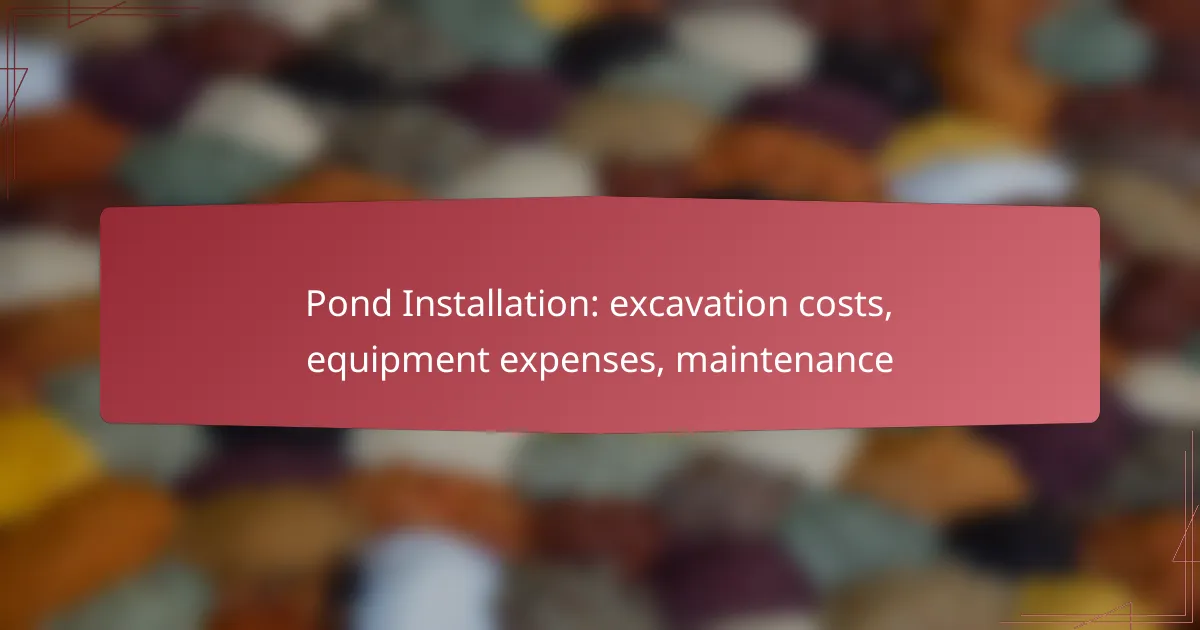Tree planting is a vital practice that enhances urban environments, requiring careful consideration of species selection to ensure adaptability and resilience. The costs associated with planting can vary widely, influenced by factors such as location and ongoing care needs. Proper maintenance, including watering and pruning, is essential for the long-term health and vitality of newly planted trees.
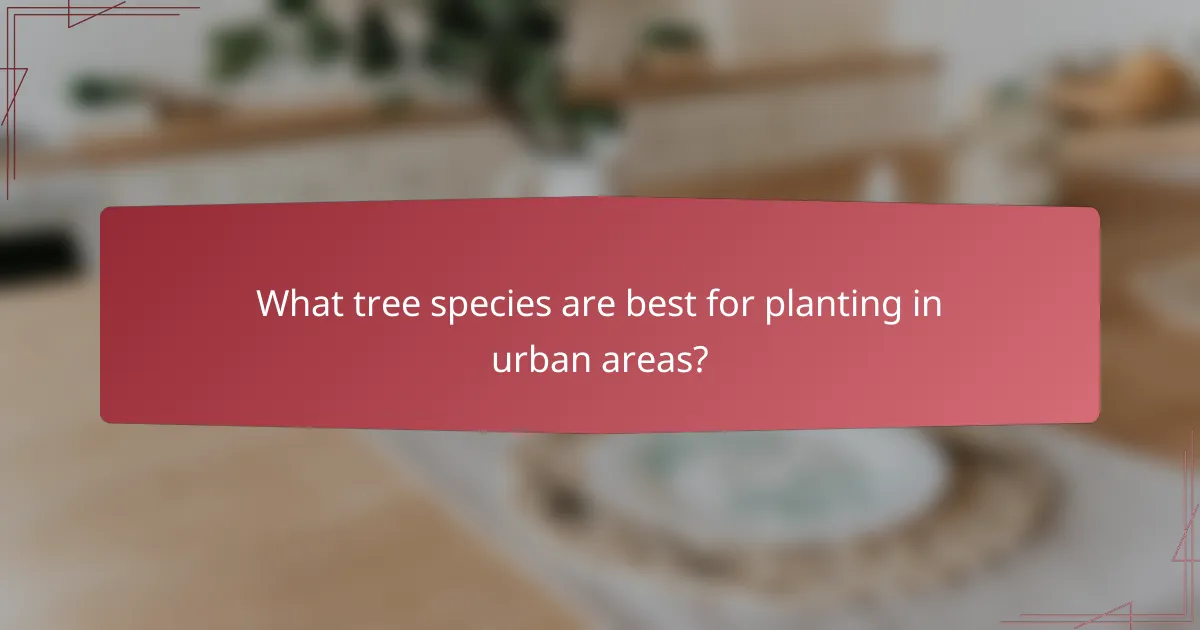
What tree species are best for planting in urban areas?
Choosing the right tree species for urban areas involves considering factors such as adaptability, growth rate, and resilience to environmental stressors. Native species, fast-growing varieties, and drought-resistant options are often the best choices for urban settings.
Native species like Oak and Maple
Native species such as Oak and Maple are well-suited for urban environments due to their ability to thrive in local soil conditions and support local wildlife. These trees typically require less maintenance and are more resistant to pests and diseases common in their native habitats.
When selecting native trees, consider their mature size and canopy spread to ensure they fit well within the urban landscape. Oaks can grow large and provide significant shade, while Maples offer beautiful fall colors and moderate growth rates.
Fast-growing species like Birch and Willow
Fast-growing species like Birch and Willow are ideal for quick shade and aesthetic appeal in urban areas. Birch trees can grow several feet per year and are known for their striking white bark, making them visually appealing in parks and streetscapes.
Willows, particularly weeping varieties, thrive near water sources and can help manage stormwater runoff. However, their rapid growth can lead to a shorter lifespan, so plan for eventual replacement or maintenance as they mature.
Drought-resistant species like Redbud
Drought-resistant species such as Redbud are excellent choices for urban areas facing water restrictions or dry conditions. These trees are adapted to survive with minimal water once established, making them sustainable options for cities with limited irrigation resources.
Redbuds offer beautiful spring blooms and moderate growth, making them suitable for smaller spaces. When planting drought-resistant trees, ensure they are placed in well-draining soil to maximize their resilience and longevity.
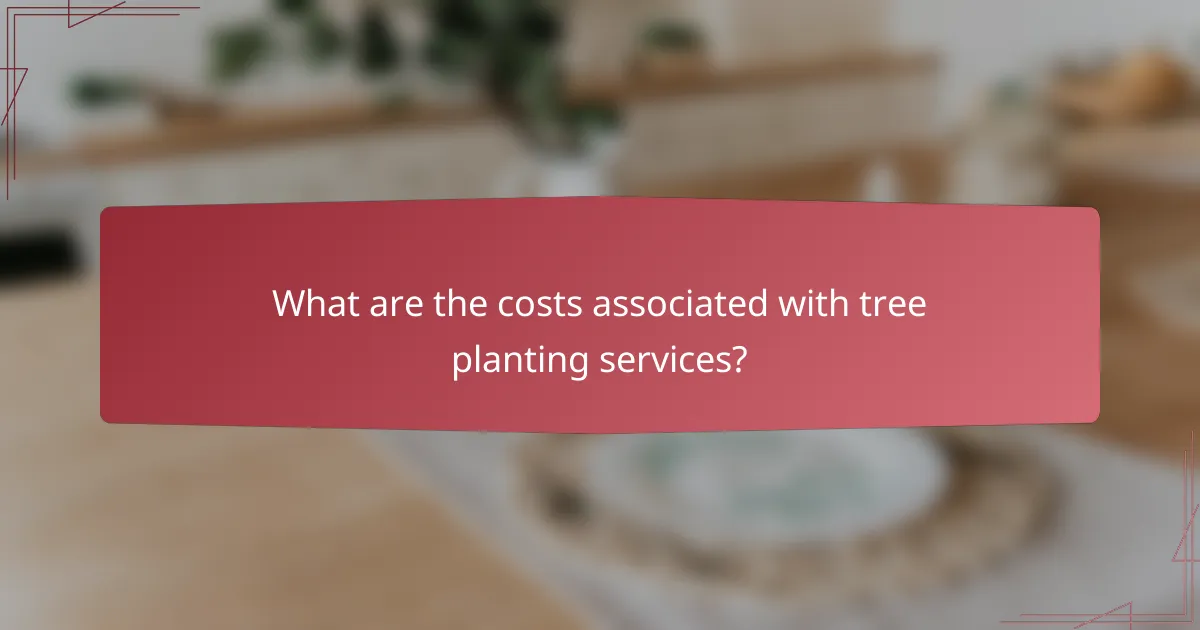
What are the costs associated with tree planting services?
The costs associated with tree planting services can vary significantly based on several factors, including location, species selection, and long-term care requirements. Generally, homeowners can expect to spend anywhere from a few hundred to several thousand dollars for professional planting services.
Average costs per tree in Los Angeles
In Los Angeles, the average cost to plant a tree typically ranges from $150 to $500 per tree, depending on the species and size. This price often includes the cost of the tree, labor, and any necessary materials such as soil amendments or mulch.
For larger or more mature trees, costs can escalate to $1,000 or more. It’s advisable to obtain multiple quotes from local tree planting services to ensure competitive pricing.
Factors affecting planting costs
Several factors influence the overall costs of tree planting services. The size and species of the tree are primary considerations, as larger trees generally require more labor and resources. Additionally, the complexity of the planting site, such as soil quality and accessibility, can affect costs.
Other factors include local labor rates and any additional services requested, such as irrigation installation or ongoing maintenance. Understanding these variables can help in budgeting effectively for tree planting projects.
Cost comparisons for different species
When comparing costs for different tree species, it’s essential to consider both the initial planting price and the long-term care requirements. For instance, native species may have lower planting costs and require less maintenance, while exotic species might be more expensive to plant and care for.
Here’s a brief comparison of common tree species and their associated costs:
- Oak: $300 – $800
- Pine: $200 – $600
- Maple: $250 – $700
- Citrus: $150 – $500
Choosing the right species not only impacts initial costs but also affects long-term maintenance expenses, making it crucial to select trees that fit both budget and environmental conditions.

How to care for newly planted trees?
Caring for newly planted trees involves consistent watering, appropriate fertilization, and proper pruning. These practices help ensure healthy growth and long-term vitality.
Watering schedules for young trees
Young trees require regular watering to establish strong roots. A general guideline is to water them deeply once a week, providing about 10 to 15 liters of water each time, depending on the tree species and soil conditions.
During hot or dry spells, you may need to increase the frequency to twice a week. Always check the soil moisture; if it feels dry an inch below the surface, it’s time to water.
Fertilization guidelines for optimal growth
Fertilizing young trees can promote healthy growth, but timing and type are crucial. Use a balanced, slow-release fertilizer in early spring, applying it according to the manufacturer’s instructions, typically around 0.5 to 1 kg per tree.
Avoid over-fertilizing, as this can harm the tree. If the soil is rich in organic matter, you may not need additional fertilizers for the first year.
Pruning techniques for health
Pruning is essential for shaping young trees and removing any dead or damaged branches. Focus on removing competing leaders and crossing branches to encourage a strong central leader.
Perform pruning during the dormant season, typically late winter or early spring, to minimize stress. Limit pruning to about 20% of the tree’s canopy in the first few years to promote healthy growth.

What permits are required for tree planting in Los Angeles?
In Los Angeles, you typically need a permit for planting trees in public spaces, while private property may have fewer restrictions. It’s essential to check with local authorities to ensure compliance with city regulations and guidelines.
City regulations for public spaces
When planting trees in public spaces, you must adhere to the Los Angeles Department of Recreation and Parks guidelines. This includes obtaining a permit that specifies the type of tree, its location, and maintenance responsibilities. The city often requires trees to be selected from an approved species list to ensure compatibility with the urban environment.
Additionally, you may need to consider factors such as the tree’s mature size, root system, and potential impact on nearby infrastructure. Engaging with city planners can help navigate these requirements effectively.
Homeowner association guidelines
If you live in a community governed by a homeowner association (HOA), you may face additional rules regarding tree planting. HOAs often have specific guidelines about tree species, placement, and maintenance to maintain aesthetic standards within the neighborhood.
Before planting, review your HOA’s covenants and restrictions. Some associations may require approval for any new trees, while others might have a designated list of acceptable species. Always consult with your HOA to avoid potential fines or removal of your newly planted trees.
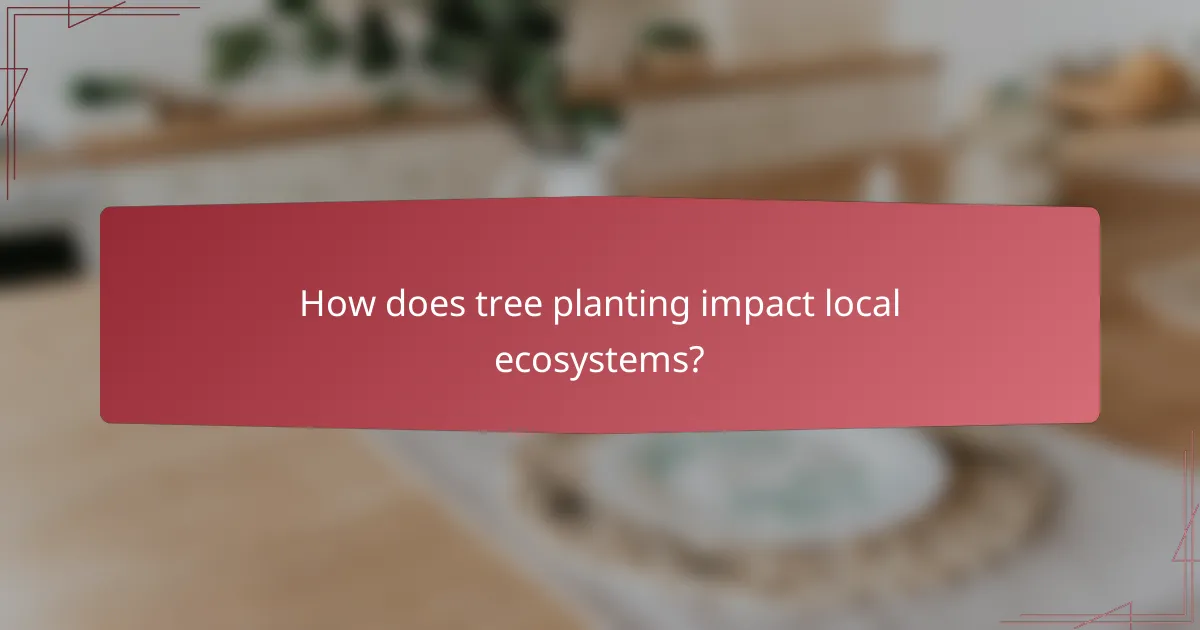
How does tree planting impact local ecosystems?
Tree planting significantly enhances local ecosystems by providing habitat, improving biodiversity, and contributing to the overall health of the environment. Healthy tree populations support various species and help maintain ecological balance.
Benefits for urban wildlife
Tree planting in urban areas creates vital habitats for various wildlife species, including birds, insects, and small mammals. These green spaces offer food sources and nesting sites, which are often scarce in densely populated regions.
Moreover, urban trees can serve as migration corridors, allowing wildlife to navigate through cities safely. Planting native species is particularly beneficial, as they attract local fauna and promote a balanced ecosystem.
Effects on air quality
Trees play a crucial role in improving air quality by absorbing pollutants such as carbon dioxide, sulfur dioxide, and nitrogen oxides. They also release oxygen, contributing to a healthier atmosphere.
Research indicates that urban areas with higher tree density can experience significantly lower levels of air pollution. For instance, a well-placed tree can reduce particulate matter by capturing dust and other airborne particles, enhancing the overall air quality for residents.
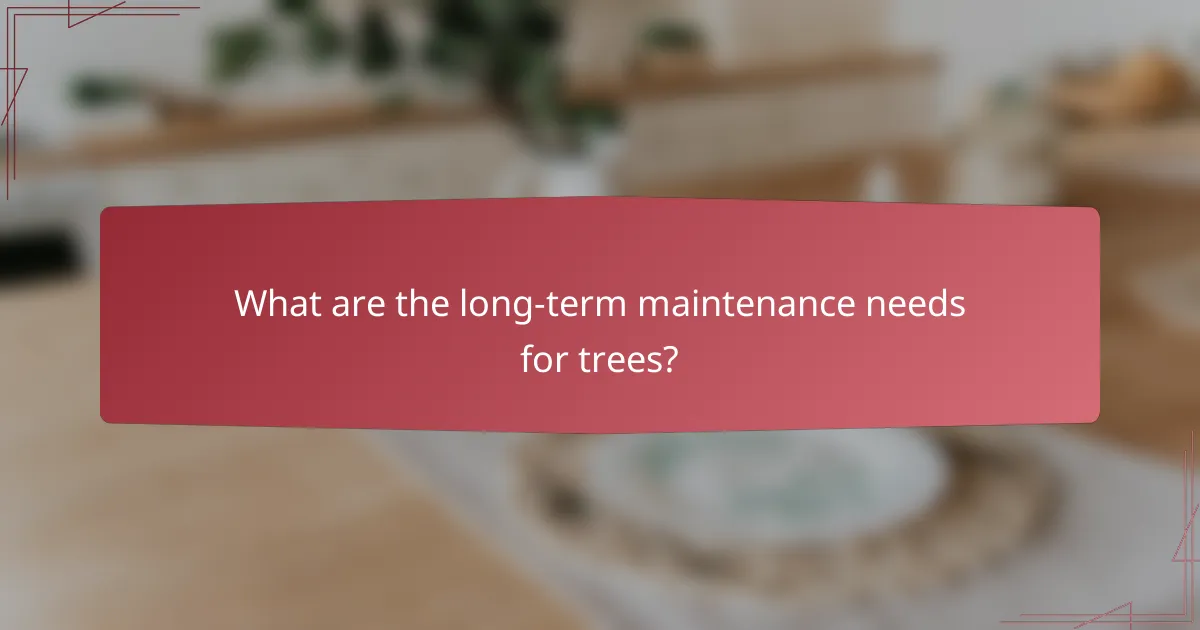
What are the long-term maintenance needs for trees?
Long-term maintenance for trees involves regular care to ensure their health and longevity. This includes routine inspections, monitoring for pests and diseases, and providing necessary resources like water and nutrients.
Regular inspections and health assessments
Conducting regular inspections is essential for maintaining tree health. Aim for assessments at least once or twice a year, focusing on signs of stress, growth patterns, and overall vitality. Look for any changes in leaf color, bark condition, or branch structure.
During inspections, consider using a checklist that includes checking for proper watering, soil quality, and surrounding vegetation. Early detection of issues can prevent more significant problems down the line, saving time and costs associated with tree care.
Common pests and diseases to monitor
Monitoring for pests and diseases is crucial for the long-term health of trees. Common pests include aphids, beetles, and caterpillars, which can weaken trees by feeding on leaves and bark. Regularly inspect for these pests, especially during the growing season.
Diseases such as root rot, powdery mildew, and cankers can also threaten tree health. Familiarize yourself with the symptoms of these conditions and consider implementing integrated pest management (IPM) strategies to address them. If you notice significant infestations or disease symptoms, consult a local arborist for professional advice and treatment options.
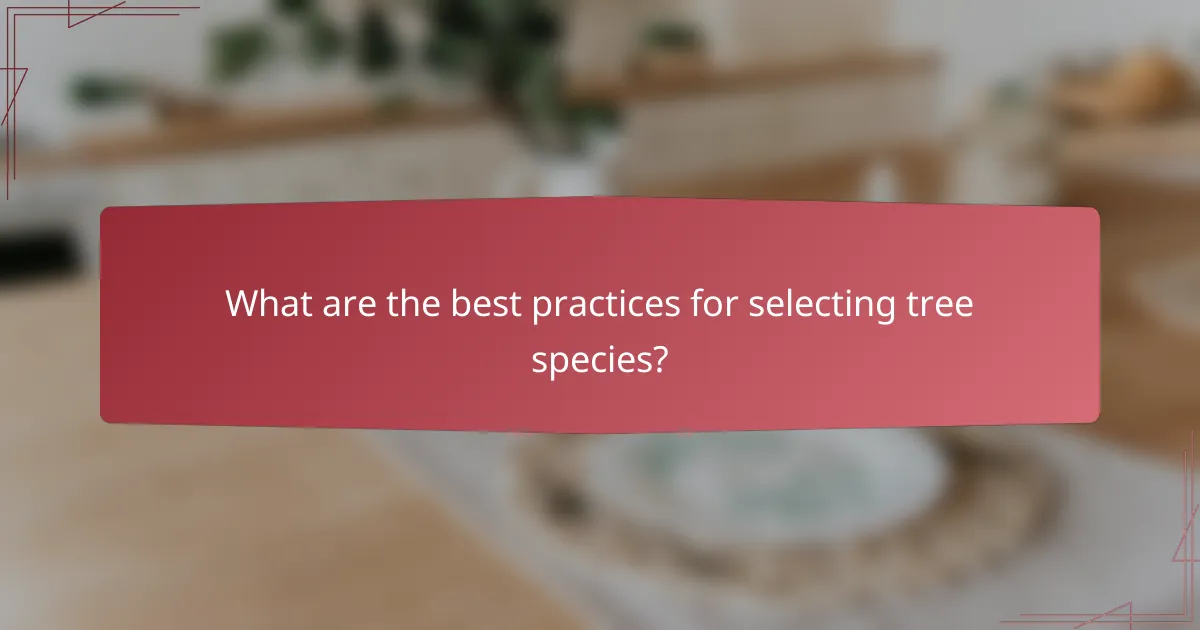
What are the best practices for selecting tree species?
Choosing the right tree species is crucial for successful planting and long-term growth. Best practices include assessing soil conditions, understanding local climate, and considering the intended purpose of the trees.
Evaluating soil conditions
Soil quality significantly impacts tree health and growth. Start by testing the soil pH, nutrient levels, and drainage capabilities. For instance, some species thrive in well-drained sandy soils, while others prefer clay or loamy soils.
Consider conducting a soil test to determine its composition and fertility. This can guide you in selecting species that will flourish in your specific soil type, reducing the risk of planting trees that may struggle to survive.
Considering climate and microclimates
Climate plays a vital role in tree selection, as different species have varying temperature and moisture requirements. Research the hardiness zones in your area to identify trees that can withstand local weather conditions.
Additionally, microclimates—small areas with different climatic conditions than the surrounding region—can affect tree growth. For example, a south-facing slope may be warmer and drier than a north-facing one, influencing which species will thrive in those locations.



